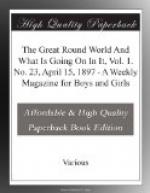This exhibition was not one of fancy work or embroideries, though every country sent some specimens of the special work for which it is celebrated. The work shown was plain sewing, the cutting and making of new garments, and the mending of old ones.
The first principles of sewing were shown on neat little squares of cloth—running, hemming, stitching, gathering, and buttonhole-making. Then there were garments in which all these first steps were applied.
While every country has sent specimens of clothing made by its children, and each exhibits its own system of teaching sewing, none of these systems seem so complete nor the finished garments so perfect as those of our own country.
In foreign countries no particular attention seems to be paid to the cutting, shaping, and ornamenting of garments. The little underclothes from Switzerland and Germany, especially, were made of such coarse cloth, of such a hideous pattern, and so utterly without ornament, that it is not pleasant to think there are really people in the world contented to wear such unsightly clothes.
In the American exhibit, every garment, for rich child or poor child, had its little frill of lace, or its row of feather-stitching, which gave it a finish that was very pretty.
The daintiest set of garments came from the Industrial School for Colored and Indian Children, in Hampton, Va.
The most complete exhibit, which included plain sewing, dress-making, hat-trimming, and fancy work of all kinds, was sent by the Pratt Institute, in Brooklyn. The useful sewing from that school was above the standard of excellence, and the art work fully equal to that of the New York School of Applied Design.
A very interesting part of the exhibit of every American school was the darning and patching. We hear a good deal about people not learning to sew properly nowadays, since the sewing-machine has come into such common use, but the patches and darns shown by the twelve-year-old pupils of our public schools would put the far-famed patching of our grandmothers to shame.
There were square patches, with the patterns matched so exquisitely that you had to feel the edge before you could realize that the patch was there; three-cornered “jags” darned so perfectly with their own threads that they were invisible, and every kind of rent and tear and hole was treated in its own particular way.
The Japanese sent a number of beautiful designs for embroidery, and a case full of queer little Japanese garments, but unfortunately they, too, were made of coarse materials, and looked ugly and uninteresting.
Russia sent Russian lace, and a number of photographs of school children learning to sew. They also sent some lovely Russian embroidery, but no plain sewing.
Mexico had a case full of wonderful drawn work; France some wonderful designs for dresses, and some beautifully finished dress-waists, but the little under-garments were as coarse as those of Switzerland. This was a disappointment, because we always suppose that France sets the fashion for daintiness.




